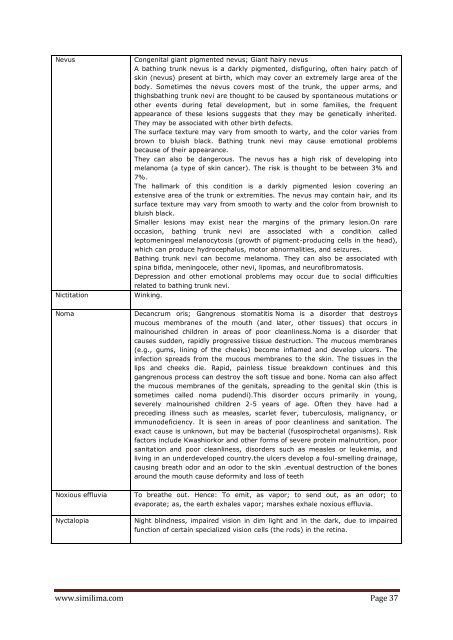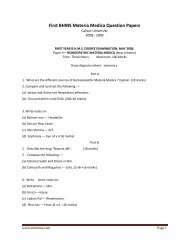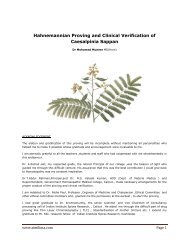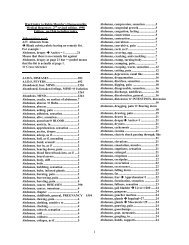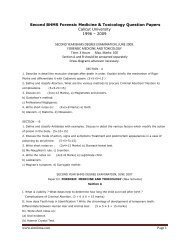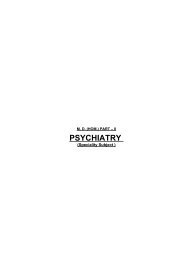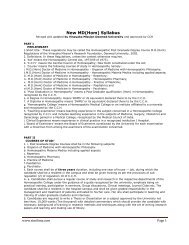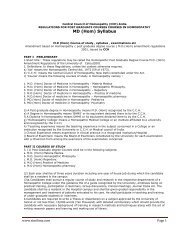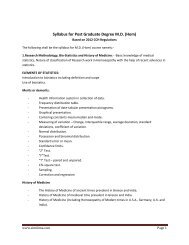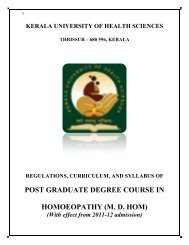Denotations & Old terminologies used in Homopathy - Similima
Denotations & Old terminologies used in Homopathy - Similima
Denotations & Old terminologies used in Homopathy - Similima
You also want an ePaper? Increase the reach of your titles
YUMPU automatically turns print PDFs into web optimized ePapers that Google loves.
Nevus Congenital giant pigmented nevus; Giant hairy nevus<br />
A bath<strong>in</strong>g trunk nevus is a darkly pigmented, disfigur<strong>in</strong>g, often hairy patch of<br />
sk<strong>in</strong> (nevus) present at birth, which may cover an extremely large area of the<br />
body. Sometimes the nevus covers most of the trunk, the upper arms, and<br />
thighsbath<strong>in</strong>g trunk nevi are thought to be ca<strong>used</strong> by spontaneous mutations or<br />
other events dur<strong>in</strong>g fetal development, but <strong>in</strong> some families, the frequent<br />
appearance of these lesions suggests that they may be genetically <strong>in</strong>herited.<br />
They may be associated with other birth defects.<br />
The surface texture may vary from smooth to warty, and the color varies from<br />
brown to bluish black. Bath<strong>in</strong>g trunk nevi may cause emotional problems<br />
because of their appearance.<br />
They can also be dangerous. The nevus has a high risk of develop<strong>in</strong>g <strong>in</strong>to<br />
melanoma (a type of sk<strong>in</strong> cancer). The risk is thought to be between 3% and<br />
7%.<br />
The hallmark of this condition is a darkly pigmented lesion cover<strong>in</strong>g an<br />
extensive area of the trunk or extremities. The nevus may conta<strong>in</strong> hair, and its<br />
surface texture may vary from smooth to warty and the color from brownish to<br />
bluish black.<br />
Smaller lesions may exist near the marg<strong>in</strong>s of the primary lesion.On rare<br />
occasion, bath<strong>in</strong>g trunk nevi are associated with a condition called<br />
leptomen<strong>in</strong>geal melanocytosis (growth of pigment-produc<strong>in</strong>g cells <strong>in</strong> the head),<br />
which can produce hydrocephalus, motor abnormalities, and seizures.<br />
Bath<strong>in</strong>g trunk nevi can become melanoma. They can also be associated with<br />
sp<strong>in</strong>a bifida, men<strong>in</strong>gocele, other nevi, lipomas, and neurofibromatosis.<br />
Depression and other emotional problems may occur due to social difficulties<br />
related to bath<strong>in</strong>g trunk nevi.<br />
Nictitation W<strong>in</strong>k<strong>in</strong>g.<br />
Noma Decancrum oris; Gangrenous stomatitis Noma is a disorder that destroys<br />
mucous membranes of the mouth (and later, other tissues) that occurs <strong>in</strong><br />
malnourished children <strong>in</strong> areas of poor cleanl<strong>in</strong>ess.Noma is a disorder that<br />
causes sudden, rapidly progressive tissue destruction. The mucous membranes<br />
(e.g., gums, l<strong>in</strong><strong>in</strong>g of the cheeks) become <strong>in</strong>flamed and develop ulcers. The<br />
<strong>in</strong>fection spreads from the mucous membranes to the sk<strong>in</strong>. The tissues <strong>in</strong> the<br />
lips and cheeks die. Rapid, pa<strong>in</strong>less tissue breakdown cont<strong>in</strong>ues and this<br />
gangrenous process can destroy the soft tissue and bone. Noma can also affect<br />
the mucous membranes of the genitals, spread<strong>in</strong>g to the genital sk<strong>in</strong> (this is<br />
sometimes called noma pudendi).This disorder occurs primarily <strong>in</strong> young,<br />
severely malnourished children 2-5 years of age. Often they have had a<br />
preced<strong>in</strong>g illness such as measles, scarlet fever, tuberculosis, malignancy, or<br />
immunodeficiency. It is seen <strong>in</strong> areas of poor cleanl<strong>in</strong>ess and sanitation. The<br />
exact cause is unknown, but may be bacterial (fusospirochetal organisms). Risk<br />
factors <strong>in</strong>clude Kwashiorkor and other forms of severe prote<strong>in</strong> malnutrition, poor<br />
sanitation and poor cleanl<strong>in</strong>ess, disorders such as measles or leukemia, and<br />
liv<strong>in</strong>g <strong>in</strong> an underdeveloped country.the ulcers develop a foul-smell<strong>in</strong>g dra<strong>in</strong>age,<br />
caus<strong>in</strong>g breath odor and an odor to the sk<strong>in</strong> .eventual destruction of the bones<br />
around the mouth cause deformity and loss of teeth<br />
Noxious effluvia To breathe out. Hence: To emit, as vapor; to send out, as an odor; to<br />
evaporate; as, the earth exhales vapor; marshes exhale noxious effluvia.<br />
Nyctalopia Night bl<strong>in</strong>dness, impaired vision <strong>in</strong> dim light and <strong>in</strong> the dark, due to impaired<br />
function of certa<strong>in</strong> specialized vision cells (the rods) <strong>in</strong> the ret<strong>in</strong>a.<br />
www.similima.com Page 37


